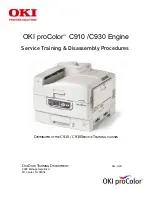
4.2 Description of Menu Items
71
UPnP
Makes settings for UPnP (Universal Plug and Play).
n
Port Status
Specifies whether to enable or disable the UPnP when the printer turns on. The default is
[Disable].
Important
• If the memory is running out when the port is enabled, the port may be disabled automatically. In this
case, you need to disable the port(s) you are not using or change the memory allocation from [Allocate
Memory].
SNMP
Set this to use SNMP. SNMP are required to use the application that remotely controls
multiple printers. The printer information is maintained in SNMP. The application obtains the
printer information from the SNMP.
n
Port Status
Specifies whether to enable or disable the SNMP port when the printer turns on. The default
is [Enable], which means the SNMP port is available.
Important
• If the memory is running out when the port is enabled, the port may be disabled automatically. In this
case, you need to disable the port(s) you are not using or change the memory allocation from [Allocate
Memory].
n
Transpt Protocol
Specifies the transport protocol used for SNMP. IPX, UDP, or both protocols can be
specified. The default is [UDP].
Note
• When using UDP, both the IP addresses of a computer and the printer are required.
• Refer to the application's manual for the protocol to be used: IPX or UDP.
n
Community (R)
* No.1 to 3 characters of 4 are available (refer to P. 83)
Specify the community name used for reading the printer management information (MIB)
with up to 12 alphanumeric characters. The default is [Unregistered].
n
Community (R/W)
* No.1 to 3 characters of 4 are available (refer to P. 83)
Specify the community name used for reading/writing the printer management information
(MIB) with up to 12 alphanumeric characters. The default is [Unregistered].
n
Community (Trap)
* No.1 to 3 characters of 4 are available (refer to P. 83)
Specify the community name used for trapping with up to 12 alphanumeric characters. The
default is [Unregistered].
Summary of Contents for B6200dn
Page 1: ......
Page 9: ...Contents 5...
Page 89: ...4 3 Menu list 85 Continued from previous page Continued on next page...
Page 90: ...86 4 Settings on the Control Panel Continued from previous page...
Page 91: ...4 3 Menu list 87 From P 85 From P 85...
Page 92: ...88 4 Settings on the Control Panel From P 85...
Page 158: ...154 A Appendix...
















































